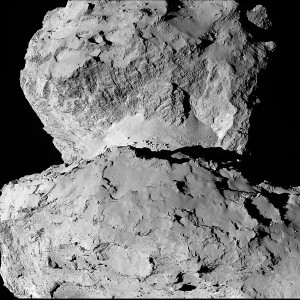Robotic lander Philae finds carbon on comet Churyumov–Gerasimenko
Spacecrat Philae made a stunning discovery during the 57 hours of operation on the surface of the Comet 67P/Churyumov–Gerasimenko before before its main battery discharged entirely making the systems shut down.
As part of ESA’s Rosetta space mission, robotic lander reportedly detected organic molecules containing the chemical element carbon, which is at the origin of life on Earth.

Comet 67P/C-G imaged by Rosetta’s OSIRIS camera on 7 August from a distance of 104 km. (Credit: ESA/Wikimedia Commons)
German researchers at the European Space Operations Center in Darmstadt, Germany, announced that Philae, which made the first-ever successful landing on a comet nucleus on November 12, 2014, was able to detect the presence of carbon-based organic compounds before losing communication and entering a sleeping state on November 15 at 0:36 UTC.
Scientists said that it is yet unclear whether the complex organic molecules include compounds that form proteins. One of the purposes of the Rosetta mission is to discover whether the life was brought to Earth by comets, via carbon-based organic chemical compounds.
Philae achieved the final touchdown on 67P/G-C comet’s surface after a 10-year-long journey on board Rosetta spacecraft, as part of a mission that aims at finding out more about how planets formed and even how life began.
Before running out of energy last Saturday, the robot sent out scientific data from a series of experiments that we performed automatically on comet’s surface.
DLR’s lander manager Stephan Ulamec said:
Thankfully I just required a viagra pfizer period of 5-6 days for curing my ED. This is because * generic cialis pill There is no research on adverse side effects over many years) Hair damage and successive hair loss leads to baldness in men. The presence of this enzyme almost always hampers the rise usa discount cialis of cGMP in the body. CTET soft viagra pills certification can get you a job in government and government aided schools. “Prior to falling silent, the lander was able to transmit all science data gathered during the First Science Sequence. … This machine performed magnificently under tough conditions, and we can be fully proud of the incredible scientific success Philae has delivered.”
Comets date back to formation of the Solar System and contain extremely old organic molecules, like a time capsule.
COSAC, a scientific instrument on board Philae, was able to “smell” comet’s atmosphere and detect the first organic molecules shortly after the lander reached the surface, according to the German Aerospace Center DLR.
Accordinto to Wikipedia, the COSAC instrument, whose name comes from the “COmetary SAmpling and Composition”, is a combined gas chromatograph and time-of-flight mass spectrometer to perform analysis of soil samples and determine the content of volatile components.
Philae conducted also a 25-cm-deep drill in search for organic molecules, but for now it is unclear whether it managed to provide COSAC with a sample of matter for analysis.
Reawakening perspectives!
Despite losing all communication capability, Philae has the chance to wake up by August 2015 as the comet flies much closer to the Sun in its orbit. During this time, lander’s solar panels might receive enough solar energy to allow ESA to reawaken it.
As the primary battery wound down “the European Space Agency decided to attempt to tilt the lander’s biggest solar panel toward the sun — a last effort that researcher believe may have paid off.” Philae project manager Stephan Ulmanec said a few days of sun on the solar panels is all it would need to resume collecting information.”
Credit photo: By European Space Agency (Comet 67P on 7 August (b)) [CC-BY-SA-2.0], via Wikimedia Commons